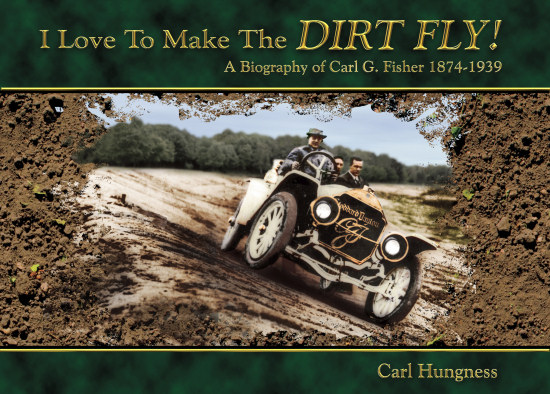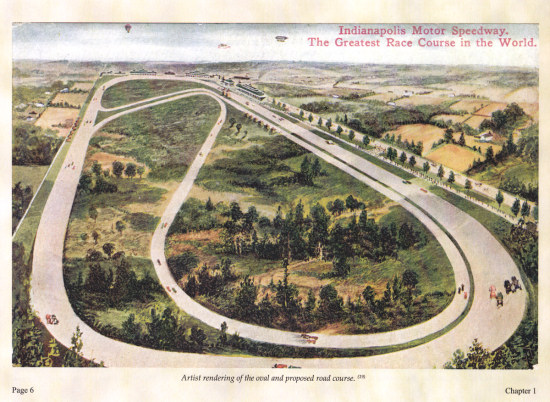The Way It Is/ I love to make the dirt fly!by Gordon Kirby |
 Veteran American auto racing writer and publisher Carl Hungness is a unique fellow with a long track record in the business. For many years Hungness published the 'Indy 500 Yearbook' and later this year he will publish his latest book, titled 'I love to make the dirt fly!', a biography of Indianapolis Motor Speedway founder Carl Fisher.
Veteran American auto racing writer and publisher Carl Hungness is a unique fellow with a long track record in the business. For many years Hungness published the 'Indy 500 Yearbook' and later this year he will publish his latest book, titled 'I love to make the dirt fly!', a biography of Indianapolis Motor Speedway founder Carl Fisher.
Hungness has spent more than fifteen years working on this project and recently he shared with me his first take on the finished pages. The book is a typically thorough Hungness effort with plenty of historical digressions and a fine selection of colorized photos. I'm sure it will become essential reading for any student of the history of American motor racing. Carl Fisher was an indomitable huckster and salesman who started his working life pedaling magazines and bicycles before making his mark as the key moving force behind creating and building not only the Indianapolis Motor Speedway but also Miami Beach. He's also considered the father of the Lincoln and Dixie Highways, America's first interstate road systems, and the creator with IMS partner Jim Allison of Prest-O-Lite, manufacturer of the first mass market automobile headlight. The title for Hungness's book comes from Fisher's love of carving something out of an empty field or wilderness. 'I love to make the dirt fly!' was one of Fisher's favorite sayings which he would deliver with a wide grin at the site of one of his latest field or forest-clearing construction sites. He also loved high society, polo, parties and alcohol, but eventually he became a increasingly unhealthy diabetic.  © Carl Hungness Publishing Fisher was born in rural Indiana and grew up in Indianapolis with two brothers, Earl and Rollo. They were raised by a strong, single mother named Ida. Carl left school after the sixth grade to work first in a grocery store, then a bank before starting his career as a salesman. Young Fisher worked on the B&O railroad as a 'hawker' selling newspapers, magazines and books and was able to make enough money to open his own bicycle sales and repair shop in downtown Indianapolis before he was 20 years old. During this time Fisher started racing bicycles and after a visit in 1900 to a show for the burgeoning horseless carriage industry in New York's Madison Square Garden he became a convert and soon was selling motorcycles and automobiles. His bicycle shop became 'Fisher's Garage' and then 'The Fisher Automobile Company' as he emerged as one of Indianapolis's most prosperous citizens. In October of 1908 Fisher indulged in one of his most renowned publicity stunts when he flew a hot air balloon across the skies of Indianapolis while seated in a brand new Stoddard-Dayton automobile suspended beneath the balloon! At the time the fledgling automobile industry was booming with more than 76 manufacturers setting up shop in the state of Indiana. Most of them lasted only a few years but the fever for automobiles resulted in Fisher building a giant, 2.5-mile test track on the outskirts of town in partnership with Arthur Newby and Jim Allison. The Indianapolis Motor Speedway opened in 1909, the first 500 was run two years later and the 100th running of the world's oldest race takes place next year. Of course, Fisher went on to engage in many other entrepreneurial escapades, including founding and developing the Prest-O-Lite company with Allison and Miami Beach with Henry Flagler. There's no better man than Carl Hungness to tell Fisher's story. A self-styled renaissance man, Hungness is a writer, publisher, sculptor and metal fabricator. Among his many works are a quarter-scale bronze rendering of Ralph DePalma and riding mechanic Rupert Jeffkens pushing DePalma's broken Grand Prix Mercedes across the line to finish second at Indianapolis in 1912 after dominating the race. Hungness's most recent work is a similarly-scaled clay model of Chapman Root's 1955 Sumar Special streamliner. The car is finished in carbon reinforced fiberglass and Carl is flogging a limited edition of ten reproductions for $22,500 apiece.  © Carl Hungness Publishing Hungness churned out his reincarnation of Clymer's great tradition for 27 years until Tony George told him the Speedway was going to buy him out and deny him credentials so that it could begin publishing it's own annual. Titled the 'Indy 500 Review' the IMS's book lasted only a handful of years but by then Hungness was long-gone. Broken-hearted at being expunged from the speedway he rebuilt his life in a small town in southern Indiana, designing and manufacturing posters and working on both his sculptures and his continuing fascination and research into Carl Fisher's life. Hungness is a classic example of many people who once were passionate supporters of the Indy 500 and Indy car racing but were driven away from the sport by the infernal politics unleashed by the CART/IRL civil war. Yet in the long run Hungness and his like will provide much greater contributions than those who tried to denigrate or tear them down. In fact Hungness's biography of Fisher will serve to emphasize the immense drive and zest for life and business that brought the Indy 500 and Miami Beach to life. Fisher was a man who was always looking for new challenges, always coming up with wild ideas and schemes, always out there selling his ideas and products. He was a man who charmed and entertained people while making and losing his fortune. In all ways Fisher stands in sharp contrast to the bureaucrats and politicians who run motor racing today. Last week, IndyCar announced new rules placing strict restraints on any public criticism drivers or team members may make about the sport. Rather than trying to expand the sport's spectacle and appeal, IndyCar is desperately trying to fence everyone in amid an attempt to tamp down and contain the criticism and negativity surrounding the series. It's the complete opposite of Carl Fisher's approach to life and business and about as un-American as you can be. As an antidote to all that 'I love to make the dirt fly!' will provide readers with a thorough appreciation of the spirit that made both the Indy 500 and America great. Hungness's book is expected to come off the press this fall and will be available in December in time for Christmas. You can buy the book from Carl Hungness Publishing in Madison, IN for $59.95 plus $5 for postage and handling. Carl's email is carlhungness@frontier.com. He tells me the IMS's gift shop will also carry the book. We can only hope therefore that some of the people who make the decisions on Sixteenth St. will read Fisher's story and begin to realize he personified a much more entrepreneurial, brighter, wider, more creative and inclusive way of doing business than the sport's leaders have demonstrated in recent decades. A healthy dose of Fisher's spirited salesmanship surely would work wonders. |
|
Auto Racing ~ Gordon Kirby
Copyright ~ All Rights Reserved |
